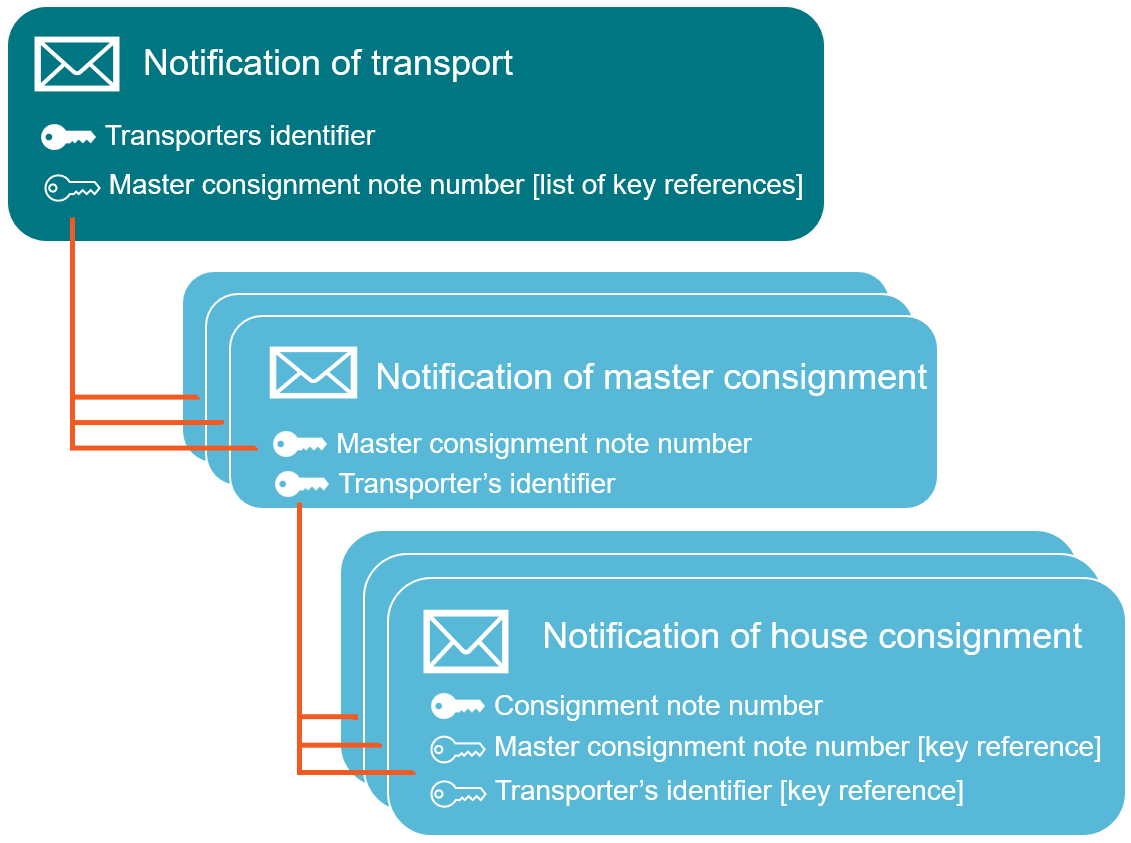Linking Messages
Generally, messages in notification and information are linked through keys provided by the sender.
Linking between Transport and Master Consignment
The transport message contains a list of keys to
master consignment messages. In that list, the key
to a master consignment is provided, which consists
of the master waybill number
(transportDocumentMasterLevel.documentNumber+transportDocumentMasterLevel.type).
For the link to be correct, the carrier's identifier
must be the same in the master consignment message
(carrier.IdentificationNumber) and the
transport message
(carrier.IdentificationNumber).
Linking between Transport and House Consignment – without using Master Consignment
The transport message contains a list of keys to
house consignment messages. In that list, the key
to a house consignment message is provided, which
consists of the waybill number
(transportDocumentHouseLevel.documentNumber +
transportDocumentHouseLevel.type). For the
link to be correct, the carrier's identifier must be
the same in the house consignment message
(tranportLevel.carrierIdentificationNumber)
and the transport message
(carrier.IdentificationNumber).
In the house consignment message, a flag must be set
to indicate that this is a consignment linked
directly to a transport: "directConsignment":
true.
Linking between House Consignment and Master Consignment
The house consignment message contains a key
reference to the master consignment message. In
that reference, the key to a master consignment
message is provided, which consists of the master
waybill number
(transportDocumentMasterLevel.documentNumber +
transportDocumentMasterlevel.type). For the
link to be correct, the carrier's identifier must be
the same in the house consignment message
(consignemntMasterLevel.carrierIdentificationNumber)
and the master consignment message
(carrier.IdentificationNumber).
Linking between House Consignment and Master Consignment for consignments covered by UPU conventions
The house consignment message contains a key
reference to a receptacle. In that reference in the
house consignment message, the key to a receptacle
is provided
(receptacleIdentificationNumber).
The master consignment message contains a list of
key references to receptacles. In these references
in the master consignment message, the key to a
receptacle is provided
(receptacleIdentificationNumber).

For postal operators, specific links via receptacle apply:
- by referencing the receptacle ID in both the house consignment and the master consignment (only used for postal operators)

Updating Messages (PUT)
In the same way as for submission (POST), when updating (PUT), a message must be sent and a reference (requestid) received, and then validation must be queried. PUT is a complete replacement of the previous submission and must refer to the received MRN for the message as a key. In addition to referring to the MRN, the key information for the message must remain unchanged when updating:
-
For transport, the identifier (license
plate and registration number:
identificationNumber + typeOfIdentification), route number (conveyanceReferenceNumber) (only for flights), and original arrival time (scheduledDateAndTimeOfArrival) cannot be updated. -
For master consignment, the master
waybill number (
documentNumber + type) and carrier identifier (carrierId) cannot be updated. -
For house consignment, the waybill number
(
documentNumber + type) cannot be updated.
Otherwise, updating (PUT) follows the same pattern as submission (POST). See the API documentation linked below for details on the endpoints.
Deleting/Cancelling Messages (DELETE)
In the same way as for submission (POST) and updating (PUT), when deleting (DELETE), a message must be sent and a reference (requestid) received, and then validation must be queried. DELETE cancels the previously submitted message and must refer to the received MRN for the message as a key. Otherwise, deleting (DELETE) follows the same pattern as submission (POST) and updating (PUT). See the API documentation linked below for details on the endpoints.
Automatic Cancellation of Messages
Transport messages are automatically cancelled 72 hours after the estimated arrival if the arrival is not registered. Master consignment/house consignment messages that are not linked to a transport will be cancelled 30 days after the last update of the message.

